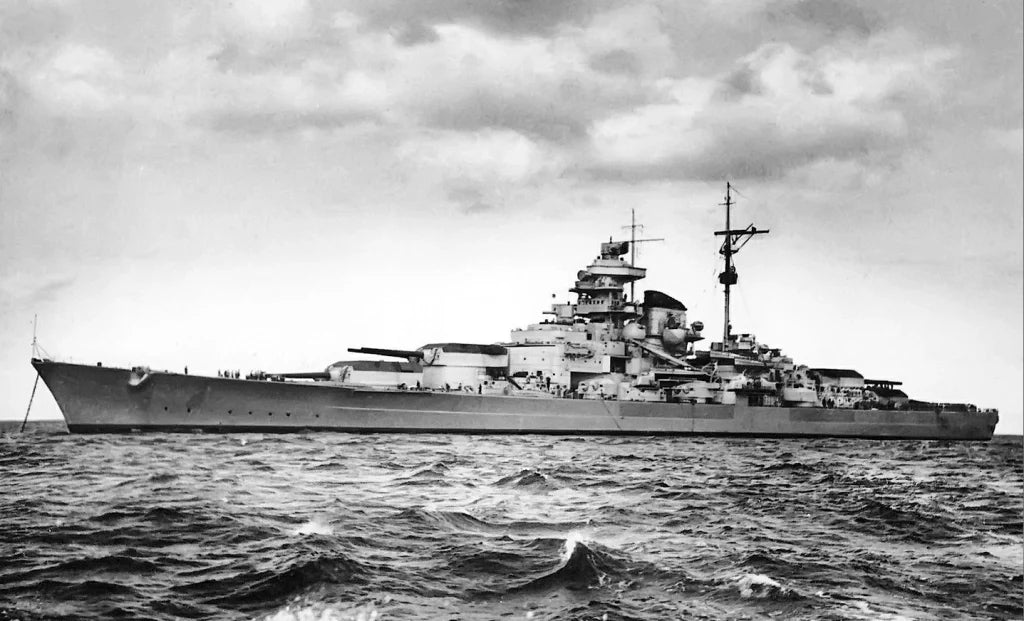The saga of the German battleships Tirpitz and Bismarck unfolds as an enthralling narrative amidst the chaotic backdrop of World War II naval history. These titanic maritime forces, renowned for their vast dimensions and critical strategic importance, were integral to the Kriegsmarine’s bold naval tactics. In this comprehensive exploration, we delve into their intricate design philosophies, thorough operational histories, and the unique roles they assumed on the broad canvas of naval warfare, offering a profound analysis of their significant impact and enduring legacy.
Conception and Construction
Launched into a Europe overshadowed by the burgeoning storm of war, the Bismarck and Tirpitz epitomized the zenith of naval engineering of their epoch. Arising from the aggressive military expansion plans of Nazi Germany, these battleships were meticulously engineered to showcase the apex of naval durability, formidable firepower, and unparalleled speed. The Bismarck, embarking on its initial voyage on February 14, 1939, and the Tirpitz, debuting on April 1, 1941, were each outfitted with eight 15-inch guns strategically positioned in four twin turrets, primed to deliver devastating broadsides.
Operational Endeavors and Tactical Deployments
Though meteoric, the Bismarck’s operational life was marked by significant engagements that demonstrated its formidable capabilities. Its inaugural and final mission, Operation Rheinübung, intended to disrupt Allied shipping between America and Britain, showcased its strength with the sinking of HMS Hood. This triumph, however, presaged its eventual ruin. Relentlessly pursued by a furious Royal Navy, the Bismarck succumbed to its inevitable fate on May 27, 1941. This episode stands as a profound testament to the paradoxical blend of immense power and intrinsic fragility that characterized these monumental naval titans.
In stark contrast, Tirpitz’s operational strategy was largely characterized by its role as a strategic deterrent. Moored in the seclusion of Norwegian fjords, it was a constant threat to Allied naval and shipping operations, especially those aiding the Soviet Union. Its mere presence required disproportionate Allied resources to contain it, a testament to its strategic value. Despite its limited direct engagement, the Tirpitz’s influence on Allied strategy was profound until its sinking by British Lancaster bombers on November 12, 1944, during Operation Catechism.
Comparative Analysis and Strategic Impact
The Bismarck’s brief but vibrant service highlighted the potential and peril of surface raiders in naval warfare, underscoring the changing dynamics of naval engagements influenced by technological advancements such as radar. On the other hand, the Tirpitz’s role as a fleet-in-being exemplified the strategic utility of naval power as a means of psychological and resource-focused warfare, altering Allied operational plans without firing a single shot in battle.
Reflections on Legacy
The legacies of Tirpitz and Bismarck transcend their physical destruction. They exemplify the dual nature of naval power—both as a direct force capable of formidable engagement and as a strategic tool that commands attention and resources far disproportionate to its actual deployment. Their stories are emblematic of the broader strategic shifts during World War II, where the balance of power often rested not just on visible actions but also on the perceived threats and tactical posturing that shaped the decisions of nations at war.
In contemplating the monumental histories of the Tirpitz and Bismarck, one gains insight into the intricate dance of war, where ships are not merely vessels of steel and gunpowder but chess pieces on the vast board of global strategy, each move and countermove resonating through the annals of history.
For more insights into the German Battleship Tirpitz Nautical. and other important military aircraft, visit Aces In Action. Here, you’ll find an amazing piece of artwork by Craig Tinder titled “Operation Zitronella,” which illustrates the “Lonely Queen of the North” – the German Battleship Tirpitz on her raid on the Svalbard Archipelago on September 8, 1943. The limited edition canvas print even includes a piece of artifact that was recovered from the final resting place of the Tirpitz in June 1974 by the distinguished British Sub-Aqua Club, making it a unique piece of history!
Operation Zitronella – German Battleship Tirpitz Nautical Relic Art by Craig Tinder
8 September 1943 – German battleships, Tirpitz and Scharnhorst, led a raid on the Allied-occupied Svalbard Archipelago in the Arctic on a mission to disrupt Allied infrastructure and demonstrate the value of the remaining surface fleet. Their presence not only inflicted considerable damage on the infrastructure and resources on the island but also demonstrated Germany’s ability to project naval power in the Arctic. The raid was considered a minor success and would serve as Tirpitz’s only offensive action. She was often referred to as the “Lonely Queen of the North,” being particularly notable as the heaviest battleship ever built by a European navy.
To purchase or see similar items, visit here.Commissioned by Museums, Treasured by Collectors





Share:
Danger in the Skies: The B-24 Liberator’s ‘Flying Coffin’ Nickname Explained
Silent Predator: USS Atule’s Stealth and Strategic Impact